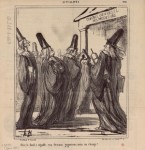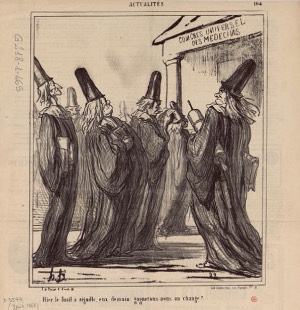
 Caricature by Honoré Daumier (1808-1879), "Hier le fusil à aiguille, eux demain : gagnerons-nous au change ?" ("Yesterday the needle gun, tomorrow them: will we win at the exchange?"), Le Charivari, June 8, 1867, Musée des Beaux-Arts de Marseille.
Caricature by Honoré Daumier (1808-1879), "Hier le fusil à aiguille, eux demain : gagnerons-nous au change ?" ("Yesterday the needle gun, tomorrow them: will we win at the exchange?"), Le Charivari, June 8, 1867, Musée des Beaux-Arts de Marseille.
Nowadays, a syringe is an essential tool in the medical field. It is an instrument consisting of a piston and a cylindrical pump body fitted with a nozzle where a needle fits to inject a product. However, this current model is vastly different from the one launched in the middle of the 19th century.
The redesign of the injection process is due to two doctors, one Scottish, Alexander Wood (1817-1884) and one French, Charles Gabriel Pravaz (1791-1853). In 1852, Dr Pravaz updated an invention of another French physician, Dominique Anel, who created a silver syringe appreciated for its practicality. A year later, in 1853, Dr Wood injected a product subcutaneously, for the first time, with a hypodermic syringe of his invention. This model has quickly spread thanks to its robustness. The all-glass syringes were considered too fragile and dangerous. It was only in 1956 that plastic syringes appeared in order to solve this material problem.
We owe the arrival of the syringe to new industrial techniques discovered in the 19th century. In fact, scientists started to extract active ingredients from medicinal plants. For example, Wood’s syringe was used to inject morphine, a tranquilliser extracted from opium, which was discovered in 1804 and used for patients with aneurysms.
Afterwards, soldiers of the 1870-1871 war were advised by doctors to inject morphine to raise morale. Quickly, patients started to abuse it. Some doctors demanded to control its use to stop morphine addiction. The syringe was used for the commercial and recreational use of morphine, which relieved pain in some patients and non-patients, as was in the case in the opium dens of London. Then, the syringe spread to the medical staff, soldiers, merchants, and individuals.
The 1853 syringe by Wood and Pravaz is a medical breakthrough, per se, but with limits. The biggest problem in the 19th century was sterilisation. It was not until 1974, that disposable syringes were invented by Phil Brooks. The object is also at the centre of many controversies. The many debates on the subject in the Chamber of Deputies were proof of this. On 12 January 1922, the minister of pensions prohibited medical device companies from delivering equipment such as thermometers, and Pravaz’s syringes to the population. Deputy Gustave Delory, on 24 November 1922, asked the minister to abolish this law to relieve doctors, especially in the countryside where they are solicited a lot. The demand was rejected because the presence of doctors seemed necessary during the use of the equipment. The Chamber reminded that medical device companies could directly deliver to patients’ homes, so doctors wouldn’t have to carry all this material (prostheses, orthopaedic equipment). The use of the syringe spread to households at the beginning of the 20th century, but the goal was to limit its use without the presence of a professional.
Nowadays, syringes are not only used in medical centres, but are also used in prisons where inmates inject drugs. There, the needles circulate among them, as they are not available on a self-service basis. The government has, therefore, set up a plan called PES (Programme d’échanges de seringue/syringe exchange program) which, since 1995, has provided access to health materials such as syringes for populations that do not frequent healthcare facilities.
Read more in the dictionary: LSD
Read the paper in French : Seringue
Références :
Thomas Grauchwell, 30 000 ans d’inventions, Grund, 2009.
Arnould De Liedekerke, La belle époque de l’opium, La Différence, 2001.
To quote this paper : Matéo Pilon, “Syringe”, in Hervé Guillemain (ed.), DicoPolHiS, Le Mans Université, 2023.